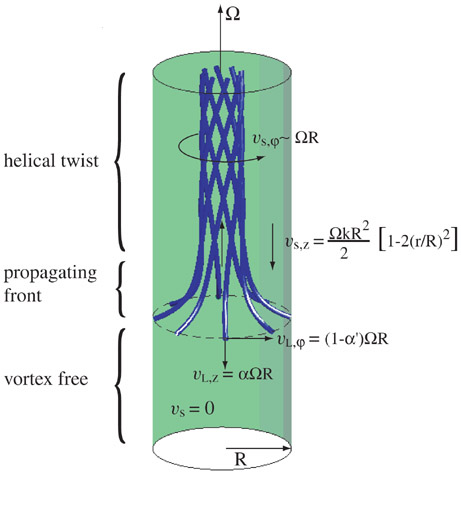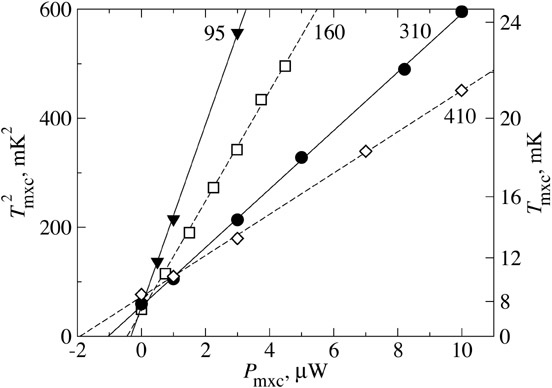
Dynamics in coherent quantum systems
S. Boldarev, V. B. Eltsov, A. Finne, R. Hänninen, J. Kopu, M. Kujala, A. Kulvik, M. Krusius, T. Ruokola
Visitors: A. Gordeev, Z. Janú, W. Schoepe, L. Skrbek, M. Tsubota, E. Thuneberg
This research project investigates topological defects in coherent quantum systems. The state of a coherent many-body quantum system is described with an order parameter field which may contain defects of different dimensionality and structure. These are topologically stable owing to the continuity requirements imposed on the quantum condensate. The most important example is a quantized line defect – a vortex line in superfluids or a flux line in superconductors. The goal of our work is to resolve the underlying order parameter structure of the defect, its nucleation, annihilation, and the various dynamic phenomena which govern its propagation and distribution.
Our work concentrates primarily on helium-3 superfluids with a multi-component vectoral order parameter field. The largest variety of defects of different topology and structure is found there. These Fermi systems are experimentally clean, structurally simple, and theoretically well understood. They can effectively be used as laboratory analogue models to study general questions common to coherent quantum systems or problems of even wider significance, which cannot be tackled by direct observation.
Superfluid turbulence: Our recent research has been concerned with the nature of superfluid hydrodynamics as a function of vortex damping. The damping arises from the coupling between the superfluid and normal components, known as mutual friction. In our measurements we track the number of vortices with NMR techniques. It turns out that in the isotropic 3He-B phase at high-temperatures the number of vortices remains a conserved quantity in dynamic processes, i.e. at high mutual friction damping the evolution of vortices follows predictable regular trajectories. This is similar to the situation in superconductors. Below 0.6 Tc an abrupt transition takes place to turbulent hydrodynamics, when the dissipative friction component drops to such low level that vortices start to travel with the externally applied flow, owing to the presence of a reactive component in mutual friction. In this regime the number of those vortices, which are in a state of dynamic evolution, increases in a sudden turbulent burst to the equilibrium value of the rotating flow state. This situation is known from superfluid 4He. Thus this experiment bridges the gap in dynamics between superconductors and traditional He superfluidity. The controlling element in this distinction is mutual friction dissipation, a feature whose importance had not been properly appreciated prior to our experiment.
Our experiment is performed similar to modern efforts in classical turbulence or a typical study of superfluid turbulence in simulation calculations. A vortex-free state at high flow velocity is created in which a seed vortex loop is injected. We have at present three techniques available for injection:
The three injection methods are complementary, revealing different aspects of vortex dynamics in applied flow. We have employed them to study three different questions:
These three processes are described below.
1) Vortex multiplication in applied flow - the precursor to superfluid turbulence: We have investigated the precursor mechanism to superfluid turbulence in rotating 3He-B, the process by which the number of quantized vortices increases from one or a few initial loops to such densities that turbulence in the bulk volume can switch on. Our measurements reveal a sharp division in behaviour as a function of temperature. Below a threshold temperature of ~ 0.6 Tc a curved vortex loop starts a process of vortex multiplication, which continues until eventually the stable equilibrium state of rectilinear vortex lines is reached.
We find that vortex multiplication in the low temperature regime proceeds in two different stages. If the initial density of vortices is low, the number of vortices first grows linearly in time. When a sufficient vortex density has been locally reached somewhere in the sample, there occurs a sudden switch-on to superfluid turbulence, where the vortex number increases abruptly. The linear regime was observed here for the first time. It has the following key features:
Numerical simulation calculations by our colleagues Risto Hänninen and Makoto Tsubota in the Osaka City University exhibit a similar initial regime of linear growth in vortex number. We attribute this multiplication to the instability of single curved vortices at low vortex damping. When such a curved loop moves in the applied flow, it orients itself partly along the flow through the interplay of mutual-friction forces and the selfinduced velocity component from its own curvature. When it then collides with the sample boundary, sharp reconnection kinks are formed and excite Kelvin waves. Excitations of proper wave length and orientation with respect to the applied flow start expanding if the vortex segment connecting to the boundary has a sufficiently long section parallel to the flow. This requirement restricts the multiplication process to low temperatures. Expanding wavelike distortions may then lead to additional reconnections with the wall, to the formation of secondary loops, and to continued vortex production.
2) Structure of vortex cluster propagating in rotating superfluid column: What happens in a rotating superfluid column if one section of the column is filled with the equilibrium number of vortex lines while the rest is vortex-free? How is the originally vortex-free section dragged into rotation?

Our experiment reveals a new transient vortex state, a vortex front, which joins the two parts of the superfluid sample. The vortex front travels through the sample in a steady-state configuration at constant velocity, extending the vortex state into the vortex-free region. A time-of-flight measurement between two NMR detection coils gives the propagation velocity of the front. It turns out to be close to the axial expansion velocity of a single vortex line. Behind the front the superfluid component is approximately in solid-body rotation, but the configuration is not yet in equilibrium: The vortices are twisted in a helical structure around the rotation axis. This is inferred from an analysis of the NMR signals which are measured while the front passes through a spectrometer coil and its internal structure is scanned by the time-dependence of the absorption line shape.
Numerical simulations of the propagation dynamics were performed using two different approaches:
These simulations support the experimental conclusions about the propagation of the front and about the helical cluster behind the front.
3) Relaxation of helical vortex cluster to rectilinear lines: The twisted vortex cluster eventually relaxes to the equilibrium state of rectilinear vortex lines. The process can be most conveniently examined using the neutron absorption technique for vortex loop injection. Here the injection occurs randomly over the entire length of the long sample column. The timing of the NMR signatures arriving from our two NMR spectrometer coils allows us to locate the site of the turbulent burst since the propagation velocity is known. In this way one can determine the dependences of the relaxation time for the unwinding of the helix. The process is currently under study. Counterintuitively we find from the experiment that the relaxation process speeds up with decreasing temperature.
Technical development work: The past year was spent replacing our 3He-4He dilution refrigerator in the rotating installation with a new and more powerful precooler of the nuclear refrigeration stage. The new dilution refrigerator has been designed and constructed by Sergey Boldarev. In January 2004 the former refrigerator was cut off from its pumping head and the installation of the new device started. In the summer test runs followed, which finally were completed just before Christmas. A minimum temperature of 7 mK was measured with a residual heat leak of 1/4 µW to the mixing chamber. The maximum flow rate of the installation is 3/4 mmole/s. The new precooler will make it possible to perform measurements on the vacuum state of quasiparticle excitations in the zero temperature limit ~ 0.1 Tc ~ 0.1 mK of this system of fermion condensates.
